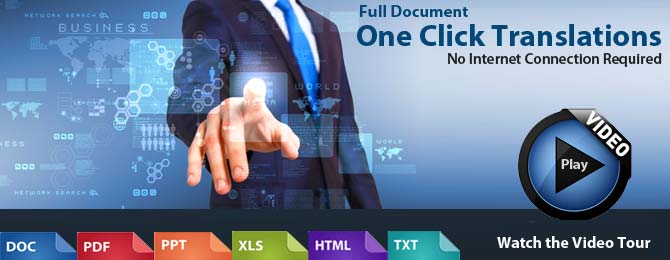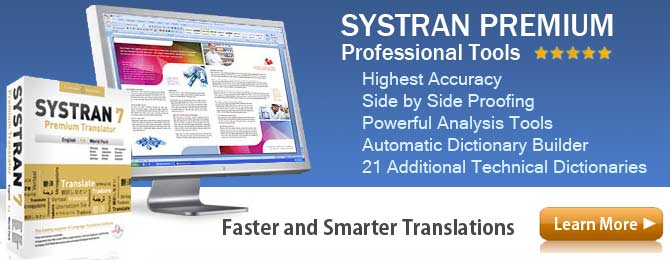SYSTRAN Software - History
SYSTRAN was launched in 1968. For over 40 years it has been producing cutting edge Translation Software that helps millions of individuals and companies worldwide save time and money when translating documents. SYSTRAN develops and distributes the world's most scalable software designed for governments, large corporations, small to medium sized companies, individual users, larger internet applications and online portals. SYSTRAN software can translate more than 50 language combinations and integrates with the most popular business applications. SYSTRAN has been the pioneer in developing natural language conversion software and applications for more than 40 years, developing products for the U.S. intelligence community, Department of Defense, the European Union and Fortune 500 companies. In the 21st Century SYSTRAN is still considered the leader in the industry and continues to deliver the latest in state-of-the-art natural language conversion software.
Consider these Facts
SYSTRAN software helps translate millions of documents every day
Systran is the Number One language converter in the world!
Systran has been the leader in translation technology for over 40 years!
The largest developer of translation technology to the US Intelligence comunity, (FBI, CIA, DOD and more). The Department of Defense, Government agencies, Fortune 500 companies and multinational groups use SYSTRAN software to convert millions of documents daily.
Development of Machine Translation
In the beginning the idea of decoding natural languages through mathematical techniques seemed overwhelming but soon became a reality after World War II. During the 1950's, research on performing Automatic Translations or Machine Translation ("MT"), took form in the sense of literal conversion, or commonly referred to as as word-for-word conversion. It was evident that the software would have to be further developed to use more complex instructions and have the software recognize the linguistic rules of each language.
SYSTRAN, leading the way with MT
Peter Toma, Ph.D., a linguist researcher for MT, began his work in 1957 at the California Institute of Technology. A few years later, Dr. Toma became involved in the initial work of developing Russian->English MT at Georgetown University, the largest MT project in the US of that time. In 1968, Dr. Toma established a company in San Diego, California, USA, with a product called SYSTRAN, an acronym for System Translation.
Soon after, the company was contracted to develop Russian->English MT for the US Air Force. The first SYSTRAN MT system was tested in early 1969 at Wright-Patterson Air Force Base in Dayton, Ohio, USA. Since 1970, the system has continued to provide language conversion for the US Air Force's Foreign Technology Division.
SYSTRAN: Then and Now
The concept of deciphering natural languages through mathematical techniques came into being after World War II. Explorations and study on MT, known today as Translation Software was set in motion. During the 1950's, nearly all of the early efforts at developing MT systems utilized closet-sized computers for word-for-word transformation, devoid of the use of any linguistic set of laws.
The growth was not rapid, trouble-free and nor was it inexpensive. In actuality, these efforts led to pitiful language conversion, consequently resulting in a definitive stop to government-sponsored research. Regardless of the huge confrontations, research was carried on.
Today the power of the desktop computers and increased computer capacities and speed are delivering a quite impressive quality that even the experts are agreeing is the wave of the future.
Systran Time Line
1968 | Systran opens in in San Diego, California and was hired to develop a full Russian to English conversion system by the US Air Force (USAF). | |
1968 | The very first SYSTRAN system was tested in early 1969 at Wright-Patterson Air Force Base in Dayton, Ohio. This system continues to offer translations to the USAF's Foreign Technology Division to this day. | |
1974 | NASA employs SYSTRAN Technology for the joint US-USSR Apollo-Soyuz space venture. | |
1975 | Commission of the European Communities (CEC) hires SYSTRAN to develop numerous European language pairs. Today SYSTRAN Software systems are totally integrated into the CEC's document workflow setting. | |
1989 | SYSTRAN is original MT developer to introduce the idea of Customer Specific Dictionaries; user-defined dictionaries that include customer words and terminology into the procedure, increasing the quality and customizing translations for users. | |
1995 | Systran Professional for Windows is launched offering a cost effective means of translation for companies. | |
1996 | SYSTRAN accepts a contract in the region of $10 million from US NAIC (National Air Intelligence Center at Wright-Patterson Air Force Base) for the expansion of quite a few Eastern European language systems, as well as the first-ever Serbo-Croatian into English system. | |
1996 | SEIKO Instruments incorporates SYSTRAN software into their electronic hand-held translators. | |
1997 | BableFish, ,the earliest online translation service, powered by SYSTRAN technology, launches on the internet. Automatic Translation becomes available to millions for free. | |
1998 | Electronic Art authorizes SYSTRAN's technology for online gaming products. | |
2000 | OracleMoblie.com , an Oracle Corporation subsidiary, chooses SYSTRAN technology for its wireless portal services. | |
2001 | Autodesk instigate the first-ever multilingual online translation of technical support documentation by means of a SYSTRAN customized solution. | |
2002 | Price Waterhouse Coopers and SYSTRAN Combine to add Multilingual Technologies to XBRL Financial Reporting Format. Providing XML Support with Systran Software for the first time. | |
2003 | SYSTRAN technology powers Atomica's multilingual fact-finder and partners with the French web portals Voila and Wanadoo. | |
2004 | Systran Professional Premium 5.0 wins European 1st Prize. This prestigious honor is awarded for groundbreaking products that represent the best of European innovation in information society technology. | |
2007 | Version 6.0 is released with a major redesign of the desktop product line. Among the features are a built-in dictionary lookup, an intuitive translation toolbar, new linguistic options, and a new interface, all of which result in significantly improved quality and increased user productivity. | |
2009 | Systran releases Enterprise 7.0 and introduces a new hybrid translation engine with both statisitical and rule based Technology. | |
2009 | Systran wins first place in an English to French translation test at the fourth annual Workshop on Statistical Machine Translation in Athens, Greece. | |
2010 | Systran joins DARPA Project. Joining Raytheon BBN Technologies on the U.S. government's GALE (Global Autonomous Language Exploitation) project to develop and apply software technologies to transcribe, translate and distill large volumes of speech and text in multiple languages. | |
2010 | Systran Training Server is released. The software contains self learning capabilities allowing software to learn from existing data to build it's own terminlogy dictionaries. | |
2011 | SYSTRAN 7.0 DESKTOP is released! The new version delivers higher accuracy in all languages. The new version offers powerful new tools that allow the software to automatically learn from previously translated documents. Dictionaries can now be built automatically! | |
2012 | Additional languages are added to the Enterprise editions. Development of languages has become faster with the SYSTRAN Training Server. Albanian, Bulgarian, Croation, Czech, Danish, Dari, Estonian, Farsi, Finnish, Hindi, Hungarian, Latvian, Lithuanian, Urdu, Turkish and Tajik are some of the addtional 37 languages added. |






